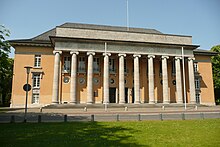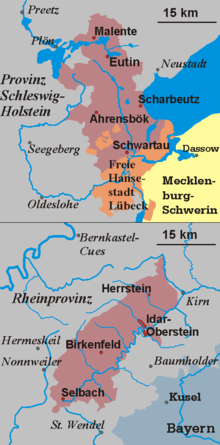Free State of Oldenburg
| coat of arms | flag |
|---|---|

|

|
| Situation in the German Reich | |

|
|
| Arose from | Grand Duchy of Oldenburg |
| Incorporated into | State of Lower Saxony |
| Data from 1925 | |
| State capital | Oldenburg |
| Form of government | Parliamentary democracy |
| Constitution | Constitution of November 30, 1920 |
| Consist | 1918 - 1934 / 1946 |
| surface | 5396 km² (May 1939) |
| Residents | 545,172 ( 1925 ); 582,400 (May 1939 ) |
| Population density | 108 inhabitants / km² (1939) |
| Reichsrat | 1 |
| License Plate | OI, O II, O III |
| map | |

|
|
The Free State of Oldenburg was a republican state of the German Empire during the Weimar Republic , which was governed as a parliamentary democracy . He was the successor state of the Grand Duchy of Oldenburg , Oldenburg after the Grand Duke Friedrich August on 11 November 1918 in the wake of the November Revolution had announced his abdication. The Free State of Oldenburg was 1933/1934 into line and went 1 November 1946 at the country Lower Saxony on.
history
1918 to 1932
After the Grand Duke renounced the throne, a workers 'and soldiers' council proclaimed the Independent Republic of Oldenburg-Ostfriesland . On November 11th, a provincial board of directors was established under Bernhard Kuhnt (USPD); this existed until March 3, 1919. The old state parliament, elected in 1911/16, confirmed the state directorate and continued to work (as the only state parliament in the Reich) until the constitutional state assembly was constituted.
In February 1919 the Reich government intervened: Kuhnt was arrested and removed from office. On February 23, a state constituent assembly was elected. On June 17, 1919, this state assembly passed the "Constitution for the Free State of Oldenburg"; on June 21st it constituted itself for the 1st state parliament and elected the Tantzen I cabinet , a coalition government of the SPD, DDP and the center.
With the founding of the Oldenburg Order Police in October 1919, a decisive turning point in the field of internal security took place. The troops, 80% financed by the Reich, actually intended to counter insurgency , were soon integrated into the individual police service in the three most important cities of Rüstringen, Oldenburg and Delmenhorst and later had district departments in the Lübeck and Birkenfeld regions.
Another state election took place on June 6, 1920. Coalition negotiations between the SPD, DDP and the center with the DVP then fail; the Tantzen government remained in office. On March 28, 1923, the Tantzen government resigned because it did not achieve a two-thirds majority in the state parliament to postpone the state elections; In view of the occupation of the Ruhr , the postponement was suggested by the Reich government . On April 17, 1923, the state parliament elected a non-party government under Eugen von Finckh ( Finckh I cabinet ; it was in office until June 22, 1925). The Finckh II cabinet (June 23, 1925 to November 14, 1930) and the Cassebohm cabinet (November 14/22, 1930 to June 16, 1932) followed.
In the state elections for the Oldenburg state parliament on May 17, 1931, the NSDAP received 37.2% of the votes, making it the strongest parliamentary group for the first time.
NSDAP government 1932/33
In the election on May 29, 1932, the NSDAP received an absolute majority - 24 out of 46 - of the seats with 48.5% of the votes, also for the first time in a country, and on June 16, Carl Röver (NSDAP) became Prime Minister elected to a NSDAP government. Three other MPs (the two of the DNVP and that of the Rural People's Party ) also voted in favor. The Röver cabinet held office until 5th / 6th May 1933.
Period of National Socialism and the post-war period
From May 1933 until the end of the war in 1945, the state, together with the state of Bremen, was subordinate to a Reich governor: until May 1942 to the previous Prime Minister Röver, then to Paul Wegener .
With effect from April 1, 1937, his two exclaves Birkenfeld and Lübeck were spun off to the State of Prussia by the Greater Hamburg Act . The Birkenfeld region was incorporated into the Rhine Province and the Lübeck region as the Eutin district (now part of the Ostholstein district ) in the Schleswig-Holstein province . At the same time, Oldenburg received from Prussia the city of Wilhelmshaven, which was formerly part of the Hanover province .
After the end of the war, initially in cooperation with the British military government, considerations took place to continue Oldenburg as an independent country. Theodor Tantzen was appointed provisional Prime Minister and formed the new State Ministry with August Wegmann (Interior), Harald Koch (Finance) and Fritz Kaestner (Churches and Schools) . In addition, a committee was set up to work out a new constitution for the state of Oldenburg, which was also passed by the appointed state parliament in spring 1946. Ultimately, this idea was rejected and Oldenburg as an administrative district part of the new state of Lower Saxony.
Rising in the state of Lower Saxony
With the ordinance No. 46 of the British military government of August 23, 1946 "Concerning the dissolution of the provinces of the former Prussia in the British zone and their new formation as independent states" , the state of Hanover received its legal basis. On 23 November 1946, the approved British military government , the unification of the country Braunschweig (except for the eastern part of the district Blankenburg and the exclave Calvörde as Office Calvörde the district of Helmstedt , attached to the Soviet occupation zone fell into the land of Saxony-Anhalt were integrated) , the state of Hanover (with the exception of the Neuhaus office , which fell under the Soviet occupation zone and was only re-incorporated into Lower Saxony in 1993), the state of Oldenburg and the state of Schaumburg-Lippe to form the new state of Lower Saxony .
On November 10, 2011, the Lower Saxony state parliament passed the law amending the law on the State Court of Justice and repealing pre-constitutional constitutional law to repeal the "Constitution for the Free State of Oldenburg of June 17, 1919 in the version of Section II Chapter 1 Part 1 § 2 of the law of April 27, 1933 (Nds. GVBl. Sb. II p. 6), last amended by Section 18 (1) sentence 2 No. 4 letter a of the law of February 10, 1972 (Nds. GVBl. p. 109) ". Until then, some parts of the constitution continued to exist as simple state law. However, these parts had become obsolete due to provisions in various state laws.
politics
Prime Minister and Reich Governor
The President of the State Directorate 1918-1919 or the Prime Ministers of the Free State of Oldenburg:
- Bernhard Kuhnt , USPD (November 11, 1918 to March 3, 1919)
- Theodor Tantzen , DDP (July 21, 1919 to April 17, 1923)
- Eugen von Finckh , independent (April 17, 1923 to July 13, 1930)
- Friedrich Cassebohm (November 14, 1930 to June 16, 1932)
- Carl Röver , NSDAP (June 16, 1932 to May 5, 1933)
- Georg Joel , NSDAP (May 6, 1933 to April 1945)
- Theodor Tantzen , FDP (April 1945 to October 31, 1946)
Reich governor for Oldenburg and Bremen based in Oldenburg:
- Carl Röver (May 6, 1933 to May 15, 1942)
- Paul Wegener (May 27, 1942 to April 1945)
coat of arms
Blazon : “Quartered; Field 1 and 4: in gold two red bars, field 2 and 3: in blue a golden cross, widened and notched at the ends, with a point at the base. "
In the regions of Lübeck and Birkenfeld, the coat of arms of the region is shown as a heart shield on the state coat of arms.
The coat of arms of the Lübeck part of the country contains a golden, floating cross in a blue field, which is covered with a bishop's cap with flying bands.
The coat of arms of the Birkenfeld part of the country is sheathed in red and silver (notice of the State Ministry of December 29, 1926 Article 1).
flag
The national flag is a blue flag, divided into four equal rectangles by a simple red cross (notice of the State Ministry of October 3, 1919 § 2).
Population and area
5396 km²; 582,400 inhabitants (May 1939)
Administrative division
The administrative structure of the Grand Duchy was largely retained in the Free State of Oldenburg, but in 1919 Rüstringen was elevated to a first-class city free of charge. The regions of Birkenfeld and Lübeck initially continued to belong to the Free State of Oldenburg.
In the course of a comprehensive administrative reform in 1933, six new offices were set up in which district offices were established. Since then, the Oldenburg region has had the following territorial division:
Cities I class (independent cities)
- Delmenhorst
- Oldenburg
- Rüstringen (until 1937)
- Wilhelmshaven (from 1937, previously part of the Prussian province of Hanover , at the same time united with Rüstringen)
Offices (from 1939 districts)
- Ammerland , formed from part of the old Oldenburg Office and the Westerstede Office
- Cloppenburg , formed from the offices of Cloppenburg and Friesoythe
- Friesland , formed from the cities of Jever and Varel and the offices of Jever and Varel
- Oldenburg , formed from part of the old Oldenburg office and the Delmenhorst and Wildeshausen offices
- Vechta , formed from the Vechta office
- Wesermarsch , formed from the offices of Brake , Butjadingen and Elsfleth
In 1939 the offices were renamed to districts . The two regions of Birkenfeld and Lübeck were reclassified from Oldenburg to Prussia in 1937.
literature
- Gerhard Köbler : Historical lexicon of the German countries. The German territories from the Middle Ages to the present . Beck, Munich 2007, ISBN 978-3-406-54986-1 (7th, completely revised edition).
- Albrecht Eckhardt : From the Grand Duchy to the Lower Saxony administrative district. The state of Oldenburg 1918–1946 . In: Jörg Michael Henneberg, Horst-Günter Lucke (ed.): History of the Oldenburger Land. Duchy, Grand Duchy, Free State . Edited on behalf of the Oldenburg landscape . Aschendorff, Münster 2014. ISBN 978-3-402-12942-5 . Pp. 189-216.
- Albrecht Eckhardt: From the socialist revolution to practical daily politics and state administration. The Directory of the Free State of Oldenburg in its protocols 1918/19 , Oldenburg (Isensee) 2017. ISBN 978-3-7308-1406-2
See also
Web links
- Search for Free State of Oldenburg in the German Digital Library
- Search for Freistaat Oldenburg in the SPK digital portal of the Prussian Cultural Heritage Foundation
Individual evidence
- ↑ a b c d Chronology
- ^ Hermann Lübbing: Oldenburgische Landesgeschichte , Oldenburg 1953, p. 141
- ↑ election results
- ↑ election results
- ↑ Results
- ↑ NLA OL Rep 400 Order. 131 No. 526 - Organization of the State Mini ... - Arcinsys detail page. Retrieved April 17, 2018 .
- ↑ Lower Saxony Law and Ordinance Gazette (5321) No. 27/2011 of November 17, 2011, p. 414
- ↑ Draft law dated June 22, 2011 on the law amending the law on the state court and repealing pre-constitutional constitutional law ( printed matter 16/3768 of the Lower Saxony state parliament )


